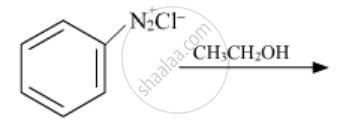Please select a subject first
Advertisements
Advertisements
Give reasons H3PO3 undergoes disproportionation reaction but H3PO4 does not.
Concept: Concept of Group 15 Elements
Give reasons When Cl2 reacts with the excess of F2, ClF3 is formed and not FCl3.
Concept: Concept of Group 15 Elements
Give reasons Dioxygen is a gas while Sulphur is a solid at room temperature.
Concept: P - Block Group 16 Elements > Sulphur - Allotropic Forms
Propanal and Propanone
Concept: Aldehydes and Ketones > Chemical Reactions of Aldehydes and Ketones - Oxidation
Account for the following:
Aromatic carboxylic acids do not undergo Friedel-Crafts reaction.
Concept: Acids > Structure of the Carboxyl group
Give reason for the following:
Primary amines have higher boiling point than tertiary amines.
Concept: Physical Properties of Amines
Illustrate the following reaction giving suitable example in each case: Diazotisation
Concept: Diazonium Salts > Method of Preparation of Diazonium Salts
Give reason (CH3)2NH is more basic than (CH3)3N in an aqueous solution.
Concept: Physical Properties of Amines
Give reason Aromatic diazonium salts are more stable than aliphatic diazonium salts.
Concept: Physical Properties of Diazonium Salts
Write the structures of the main products of the following reactions:

Concept: Amines > Chemical Reactions of Amines - Basic Character of Amines
Write the structures of the main products of the following reactions:

Concept: Amines > Chemical Reactions of Amines - Basic Character of Amines
Write the structures of the main products of the following reactions:

Concept: Amines > Chemical Reactions of Amines - Basic Character of Amines
Define the following with an example of each
Polysaccharides
Concept: Carbohydrates > Polysaccharides - Starch, Cellulose and Glycogen
Define the following with an example
Denatured protein
Concept: Proteins > Denaturation of Proteins
Write the product when D-glucose reacts with conc. HNO3.
Concept: Carbohydrates > Structures of Glucose
Write one difference between α-helix and β-pleated structures of proteins.
Concept: Proteins > Structure of Proteins
Shyam went to a grocery shop to purchase some food items. The shopkeeper packed all the items in polythene bags and gave them to Shyam. But Shyam refused to accept the polythene bags and asked the shopkeeper to pack the items in paper bags. He informed the shopkeeper about the heavy penalty imposed by the government for using polythene bags. The shopkeeper promised that he would use paper bags in future in place of polythene bags.
1) Write the values (at least two) shown by Shyam.
2) Write one structural difference between low-density polyethene and high-density polyethene.
3) Why did Shyam refuse to accept the items in polythene bags?
4) What is a biodegradable polymer? Give an example.
Concept: Introduction to Polymers > Classification of Polymers Based on Mode of Polymerisation
What is tincture of iodine? What is its use?
Concept: Therapeutic Action of Different Classes of Drugs - Antimicrobials
Among the following, which one acts as a food preservative?
Aspartame, Aspirin, Sodium Benzoate, Paracetamol
Concept: Chemicals in Food - Artificial Sweetening Agents and Food Preservatives
Read the passage given below :
1. To ensure its perpetuity, the ground is well held by the panther both in space and in time. It enjoys a much wider distribution over the globe than its bigger cousins and procreates sufficiently profusely to ensure its continuity for all time to come.
(ii) in the branches of the trees
(iii) behind the tree trunks
(iv) at its heels
(ii) trains its cubs
(iii) watches the progress of the mother
(iv) is impulsive and impatient
Answer the following questions briefly :
(ii) came down / fell (para 7)
Concept: Unseen Passage Comprehension
